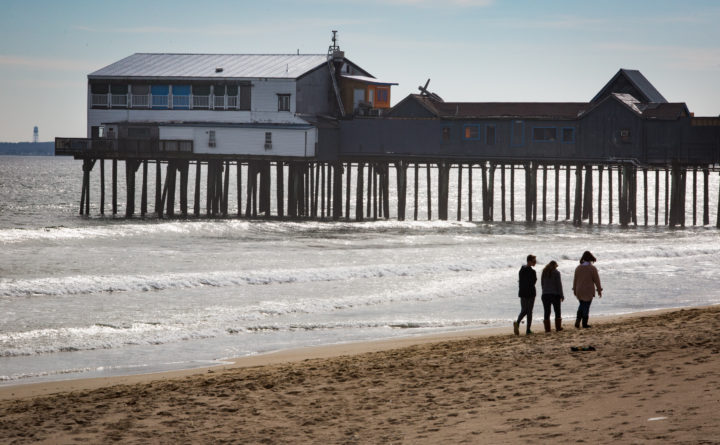
Maine’s economy is the best it has been since the great recession of 2008 as the Pine Tree State enters 2019 with a higher minimum wage, a budget surplus of more than $175 million and unemployment at 3.4 percent, below the national average.
“Most businesses and consumers are in the best shape they’ve been in over the last decade,” Bob Montgomery-Rice, president and CEO of Bangor Savings Bank, said. “Wages are slightly picking up, probably not as fast as everyone would like to see, but overall things are in a good spot.”
But upbeat predictions by economists and financiers were darkened somewhat by the partial federal government shutdown early in the new year and ongoing international trade tensions. Also clouding the financial outlook are the potential global economic slowdown, volatile stock markets, an oversupply of oil and the slowdown of China’s economy.
However, the bones of the national and state economies are strong.
“The economic fundamentals in the U.S. and Maine economies are relatively strong,” Sheena Bunnell, professor of business and economics at the University of Maine at Farmington, said. “My prediction is the economy won’t be as strong as 2018 in Maine, but it still is relatively strong.”
And that’s good news for the average Mainer.
“Overall, we do expect Mainers to be better off by the end of 2019, with personal income up slightly after adjusting for inflation,” Stefan Iris, chief investment officer for Camden National Wealth Management, said.
“Job listings should continue to be plentiful in most areas other than manufacturing,” he said. “The minimum wage increase taking effect with the start of the year will also benefit workers at the lower end of pay scales, and a tight job market may result in wage increases at higher pay grades.”
Events in China, including trade negotiations between the U.S. and Chinese governments currently underway, do have the potential to affect selected Maine economic sectors, he said, especially the agricultural and fisheries sectors.
“This poses a risk to our outlook, but we believe these matters will ultimately be resolved without damaging constraints on trade,” Iris said.
During the past year, wages and income rose about 4 percent both nationwide and in Maine, boosting consumer confidence. Demand for labor was strong, but labor shortages persist. Inflation hovered around 2 percent to 2.2 percent and is under control.
The Federal Reserve Bank increased Interest rates four times in 2018 from relatively low rates. Several economists, including Bunnell, expect the Fed to hold tight on interest rates in the new year.
“What that means to the average Mainer is that they can expect the price of a gallon of milk to be stable,” Bunnell said.
Other positive signs include Bangor Savings seeing loan delinquencies at pre-2008 crisis levels and foreclosures at an all-time low.
The bank expects to complete its $4.3 million, three-building headquarters on Bangor’s waterfront by Feb. 18, President’s Day, Montgomery-Rice said.
Interest rates are good for savers buying CDs and other financial instruments. Mortgage rates for 30-year loans still are low, but not as low as the previous 10 years.
Gas and oil prices are low so consumers will see more discretionary income. Oil prices could hover around $55 per barrel, the economists estimated.
As for a recession, the economists generally expect some type of market correction in 12 to 18 months.
“June 2019 will mark one of the longest economic recoveries and expansions in the business cycle, following the 2008-2009 recession, in U.S. history,” Bunnell said.
Positives for jobs, tourism
The plethora of help wanted signs is a constant reminder of Maine’s low unemployment rate and of the difficulty in hiring workers as the state continues to age.
But there’s some good news, according to Amanda Rector, Maine’s state economist.
“With the most recent population estimates, we saw population growth led by migration into the state, primarily from domestic locations,” she said. “This is promising to companies.”
Employment levels have continued to grow over time. The labor force participation ratio in Maine is higher than that of the United States and has been for the past three years. The participation rate is the percentage of the labor force age 16 to 64 that is working or seeking employment.
She said workers between 65 and 70 years old continue to participate in strong numbers in the workforce, which helps with the employment crunch.
“Portland and the southern part of the state should continue their economic expansion, offset by modest population declines in northern counties,” Iris of Camden National said. “The state population has the nation’s highest median age, which will continue to pose a challenge in such areas as the burden of health care costs and a relative scarcity of working-age labor supply.”
He sees job growth in the tourism and technology sectors but expects more job losses in manufacturing.
Helping the tourism industry is low oil prices for heating and fuel.
“When oil prices are low, tourists are more likely to drive to Maine and further into Maine,” Rector said.
With the stock market ups and downs and other uncertainty, Rector advises people not to panic.
“Make sure you make decisions with a clear head and not just a reaction to things you’ve seen on the news,” she said.
“Looking forward, we do not foresee a surge in inflation and for this reason we expect relatively stable interest rates in 2019,” Iris said. “Stock market ups and downs can impact the state but only indirectly, leading us to conclude that the market’s late 2018 downturn should not seriously impact economic activity in Maine.”
This article originally appeared on www.bangordailynews.com.







